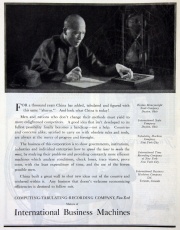Computing-Tabulating-Recording Co: Difference between revisions
No edit summary |
No edit summary |
||
| Line 11: | Line 11: | ||
1908 The '''Tabulating Machine Company''' (TMC) gave an exclusive license to the [[British Tabulating Machine Co]] of London to market its punched-card machines in Britain and the Empire. | 1908 The '''Tabulating Machine Company''' (TMC) gave an exclusive license to the [[British Tabulating Machine Co]] of London to market its punched-card machines in Britain and the Empire. | ||
1911 TMC became part of the [[Computing-Tabulating-Recording Co]] (C-T-R). | 1911 TMC became part of a new company, the [[Computing-Tabulating-Recording Co]] (C-T-R) which made timing devices, scales and slices (sic), in addition to tabulators.<ref>The Shaping of Automation: A Historical Analysis of the Interaction Between ... By Dirk de Wit (1994)</ref> | ||
1924 C-T-R was renamed International Business Machines - [[IBM]]. | 1924 C-T-R was renamed International Business Machines - [[IBM]]. | ||
Latest revision as of 16:40, 22 April 2018

Later International Business Machines (IBM).
1880s Herman Hollerith invented the punched-card technology for use in the US census[1].
1896 Hollerith formed a small business in the United States to manufacture and market his machines.
1902 Tabulating Machine Company (or TMC) owned the rights to Hollerith's machines[2].
1908 The Tabulating Machine Company (TMC) gave an exclusive license to the British Tabulating Machine Co of London to market its punched-card machines in Britain and the Empire.
1911 TMC became part of a new company, the Computing-Tabulating-Recording Co (C-T-R) which made timing devices, scales and slices (sic), in addition to tabulators.[3]
1924 C-T-R was renamed International Business Machines - IBM.

